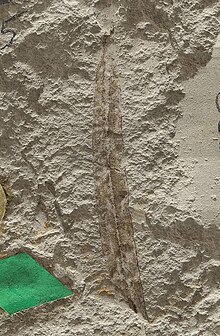Genus of conifers
Keteleeria coniferous trees in the family Pinaceae first described as a genus in 1866.[ 1] [ 2]
The genus name Keteleeria honours J.B. Keteleer (1813–1903), a French nurseryman. The group is related to the genera Nothotsuga Pseudolarix Nothotsuga by the much larger cones , and from Pseudolarix by the evergreen leaves and the cones not disintegrating readily at maturity. All three genera share the unusual feature of male cones produced in umbels of several together from a single bud, and also in their ability, very rare in the Pinaceae, of being able to coppice .
The genus is found in southern China (from Shaanxi south to Guangdong and Yunnan ), Hainan , Taiwan , northern Laos , and Vietnam .[ 3]
They are evergreen trees reaching 35 m (115 ft) tall. The leaves are flat, needle-like, 1.5–7 cm (9 ⁄16 2+ 3 ⁄4 in) long and 13 ⁄16 1+ 9 ⁄16 in) broad. The cones are erect, 2+ 3 ⁄8 –8+ 11 ⁄16 in) long, and mature in about 6–8 months after pollination; cone size and scale shape is very variable within all three species.
The variability of the cones has led in the past to the description of several additional species (up to 16 'species' have been named), but most authorities now only accept three species. Flora of China, however, recognized five.[ 4]
Phylogeny
Keteleeria heterophylloides Latah Formation , Spokane, Washington The World Checklist maintained by Kew Botanical Garden accepts the following:[ 3]
Species[ 3] formerly included[ 3] moved to Abies
Fossil record
The earliest record of the genus is from the Early Cretaceous (Barremian -Aptian ~120 million years ago) of China.[ 8]
Fossil pollen of Keteleeria caucasica have been recovered from strata of the Late Miocene in Georgia in the Caucasus region.[ 9] Keteleeria sp. fossils are known from the early Pleistocene of southern Portugal [ 10] Coldwater Beds in the Early Eocene Okanagan Highlands of Canada.[ 11] Cretaceous through Pliocene sediments in Europe, North America and Asia.[ 12]
Keteleeria caucasica Ramischvili - pollen; Miocene , Kulistskhali river , GeorgiaKeteleeria cretacea Miki & Yas. Maeda - cones; Cretaceous , Izumi Group , JapanKeteleeria ezoana Tanai - cones & seeds; Miocene , Yoshioka , JapanKeteleeria heterophylloides (Berry) Brown - leaves; Miocene , Latah Formation , Washington, USKeteleeria hoehnei Kirchheimer - cones; Miocene , Wiesa near Kamenz, GermanyKeteleeria mabetiensis (Watari) Watari - wood; Miocene , Mabechi River ; JapanKeteleeria microreticulata Ananova - pollen; Miocene , Taganrog peninsula , RussiaKeteleeria prambachensis (E. Hofm.) W. Klaus - Oligocene , Prambachkirchen , AustriaKeteleeria rhenana Kräusel - seeds; Miocene , Mainz-Kastel , GermanyKeteleeria robusta Miki - cones; Pliocene , Tokitsu , JapanKeteleeria rujadana R.N. Lakh. Oligocene Rujada flora , Oregon, USKeteleeria shanwangensis Xiang et al. - cones; Miocene , Shanwang Formation , Shandong, ChinaKeteleeria zhilinii Blokhina & O.V. Bondarenko - wood; Pliocene , Pavlovsky basin, Primorye, RussiaSeveral fossil species were formerly included in Keteleeria but have been moved:
References
^ Carrière, Élie Abel. 1866. Revue Horticole 37: 449
^ Tropicos, Keteleeria Carrière ^ a b c d Kew World Checklist of Selected Plant Families ^ "Keteleeria Carrière, Rev. Hort. 37: 449. 1866" . Flora of China 4 : 42.^ Stull, Gregory W.; Qu, Xiao-Jian; Parins-Fukuchi, Caroline; Yang, Ying-Ying; Yang, Jun-Bo; Yang, Zhi-Yun; Hu, Yi; Ma, Hong; Soltis, Pamela S.; Soltis, Douglas E.; Li, De-Zhu; Smith, Stephen A.; Yi, Ting-Shuang; et al. (2021). "Gene duplications and phylogenomic conflict underlie major pulses of phenotypic evolution in gymnosperms" . Nature Plants . 7 (8): 1015– 1025. bioRxiv 10.1101/2021.03.13.435279 doi :10.1038/s41477-021-00964-4 . PMID 34282286 . S2CID 232282918 . ^ Stull, Gregory W.; et al. (2021). "main.dated.supermatrix.tree.T9.tre" . Figshare. doi :10.6084/m9.figshare.14547354.v1 . ^ Brown, R. (1935). "Miocene leaves, fruits, and seeds from Idaho, Oregon, and Washington". Journal of Paleontology . 9 : 572– 587. ^ Zhu, Yanbin; Li, Ya; Tian, Ning; Wang, Yongdong; Xie, Aowei; Zhang, Li; An, Pengcheng; Wu, Zhenyu (April 2024). "A new species of Keteleeria (Pinaceae) from the Lower Cretaceous of Inner Mongolia, Northeast China, and its palaeogeographic and palaeoclimatic implications" . Cretaceous Research . 156 : 105805. doi :10.1016/j.cretres.2023.105805 . ^ The History of the Flora and Vegetation of Georgia by Irina Shatilova, Nino Mchedlishvili, Luara Rukhadze, Eliso Kvavadze, Georgian National Museum Institute of Paleobiology, Tbilisi 2011, ISBN 978-9941-9105-3-1
^ Fernando Reboredo, Forest Context and Policies in Portugal: Present and Future Challenges , Springer, 28 August 2014 - ISBN 978-3-319-08455-8
^ Mathewes, R. W.; Greenwood, D. R.; Archibald, S. B. (2016). "Paleoenvironment of the Quilchena flora, British Columbia, during the Early Eocene Climatic Optimum" (PDF) . Canadian Journal of Earth Sciences . 53 (6): 574– 590. Bibcode :2016CaJES..53..574M . doi :10.1139/cjes-2015-0163 . hdl :1807/71979 ^ "Keteleeria " . The International Fossil Plant Names Index . Retrieved October 1, 2023 .
External links
Wikimedia Commons has media related to
Keteleeria .

